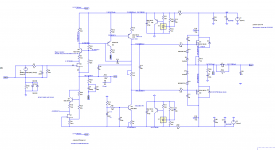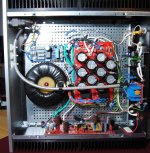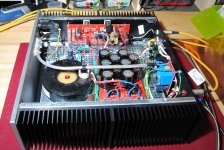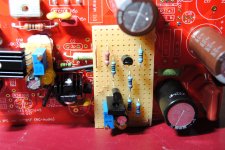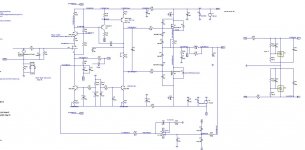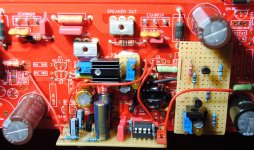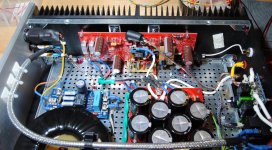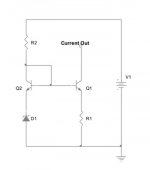I had the time to implement a shunt reg for the input stage.... it does solve offset variations due to rail voltage fluctuations....
Hope it does not interfere too much with SQ.
Q1 (Tail CCS) and Q5 (IPS) should be matched and termaly coupled to minimize offset variations due to thermals.
Hope it does not interfere too much with SQ.
Q1 (Tail CCS) and Q5 (IPS) should be matched and termaly coupled to minimize offset variations due to thermals.
Attachments
The design as show lacks a DC blocking feedback cap. I was tinkering with a design that had no input of feedback caps.
As a result DC offset can be in the 3V to 6V range. The servo needs a lot of authority to NULL this. If you add a cap, this drop below a volt and the servo can be operated with less authority, meaning R92 can be increased.
If this design was built, it would probably be wise to allow board space for this cap, so that you could audition it with and without.
As a result DC offset can be in the 3V to 6V range. The servo needs a lot of authority to NULL this. If you add a cap, this drop below a volt and the servo can be operated with less authority, meaning R92 can be increased.
If this design was built, it would probably be wise to allow board space for this cap, so that you could audition it with and without.
After trying to find a shunt reg with low drop (no luck) I decided to implement a servo.
For the servo I chose the LF411 jfet input opamp with low input noise.
This opamp is powered by shunt regs based on the TL431 voltage reference.
The final result is outstanding.
Without the servo I measured a large offset (-0.5V) that took 1 hour to drop to -10mV.
With the servo, initial offset is -8mV and drops to 0 after 10 minutes.
Strangely the sound is even better now without any bad effects on the bass response.
I also dropped the clead cap as this 10p form vas colector to FB node introduced some too obvious 2nd harmonic.
The final build has a slightly larger miller cap (39p) and the sound is fluid with very detailed bass.
Image is solid and large.
This is a very good amp.
For the servo I chose the LF411 jfet input opamp with low input noise.
This opamp is powered by shunt regs based on the TL431 voltage reference.
The final result is outstanding.
Without the servo I measured a large offset (-0.5V) that took 1 hour to drop to -10mV.
With the servo, initial offset is -8mV and drops to 0 after 10 minutes.
Strangely the sound is even better now without any bad effects on the bass response.
I also dropped the clead cap as this 10p form vas colector to FB node introduced some too obvious 2nd harmonic.
The final build has a slightly larger miller cap (39p) and the sound is fluid with very detailed bass.
Image is solid and large.
This is a very good amp.
Attachments
Please bear in mind that I am using a board from this design: https://www.diyaudio.com/forums/solid-state/258549-assemblage-power-amp-24.html#post5293375
I did not use the CCS / mirror arrangement and fed the laterals directly from the VAS/TIS that now is loaded with a CCS instead of the bootstrap.
The input device is now a jfet and it's current is also set by a ccs.
The servo signal is injected between the shunt feedback resistor and the DC blocking cap.
I did not use the CCS / mirror arrangement and fed the laterals directly from the VAS/TIS that now is loaded with a CCS instead of the bootstrap.
The input device is now a jfet and it's current is also set by a ccs.
The servo signal is injected between the shunt feedback resistor and the DC blocking cap.
I see that you are using LEDs as reference voltage for CCS. Be careful, it's very sensitive with temperature.
Its better to use more stable CCS, same as here.
// Please note that the zener D1 should be low tempco type. I usually use BZX55C6V2 or something like ''PM829'' as W.Jung suggest.
Its better to use more stable CCS, same as here.
// Please note that the zener D1 should be low tempco type. I usually use BZX55C6V2 or something like ''PM829'' as W.Jung suggest.
Attachments
Isn't the temp sensitivity of the LED the whole point? It's temp coefficient is supposed to track with the transistor's Vbe temperature coefficient and negate it making the current source temperature stable.
Are you running the amp without source resistors on the OPS? How stable is the bias? Also, is that why you switched from a bootstrapped current source to a CCS for the VAS? To keep the bias stable without needing source resistors?
I ask because I noticed the same thing in simulations. I needed a one transistor Vbe multiplier with a current compensation resistor to stabilize the bias against voltage fluctuations if the OPS is ran without source resistors and a bootstrapped VAS is used.
I ask because I noticed the same thing in simulations. I needed a one transistor Vbe multiplier with a current compensation resistor to stabilize the bias against voltage fluctuations if the OPS is ran without source resistors and a bootstrapped VAS is used.
Yes Brian, the led reference in the ccs makes it very stable temp wise.... and it has a good "tone" i have grown to apreciate.
In this case i designed the amp to sound good in the first place and measure good in second place.
My major concerns where:
1- tone
2- speed
3 - low noise
I droped the bootstrap for speed and also bias stability
In this case i designed the amp to sound good in the first place and measure good in second place.
My major concerns where:
1- tone
2- speed
3 - low noise
I droped the bootstrap for speed and also bias stability
Thank you for your input... I will look into it but normally i avoid zeners due to noise issuesI see that you are using LEDs as reference voltage for CCS. Be careful, it's very sensitive with temperature.
Its better to use more stable CCS, same as here.
// Please note that the zener D1 should be low tempco type. I usually use BZX55C6V2 or something like ''PM829'' as W.Jung suggest.
The bootstrap as i used tends to enhance voice and string instruments rendition at the expense of bass detail.Didn't realize the bootstrap Could affect speed. I'll need to take a look. Thanks for the note!
To increase bass "speed" and bite I chose to load the TIS with a ccs.
I wonder if the size of the bootstrap capacitor in your circuit impacted this. Douglas Self mentions in his book that an undersized cap can affect low frequency performance. He shows scenarios where this cap might need to be 220uF to 470uF to avoid increasing low frequency distortion.
There was a myth about the noise of zeners. Fortunately there is an member of our forum who measured, checked some popular LEDs, diodes, zeners even BE diode of small signal transistors. The result of zeners is not bad, even similar to higher cost precision reference voltage LM329DZ.
Some noise measurements for LEDs and zener diodes
Some noise measurements for LEDs and zener diodes
I wonder if the size of the bootstrap capacitor in your circuit impacted this. Douglas Self mentions in his book that an undersized cap can affect low frequency performance. He shows scenarios where this cap might need to be 220uF to 470uF to avoid increasing low frequency distortion.
I am now using 330u in my builds for this purpose but the bootstrap changes the THD spectrum and adds some 2nd harmonic that must be compensated elsewhere.
I do like bootstrapped VAS sound as it renders voices, wooden and stringed instruments more realistic but in this case I wanted to have an ultra detailed bass so I dropped it.
There is a good compromise that I use in my other build: HDRP200 High speed very low distortion singleton power amplifier
In the HDRP200 I am using a bootstraped CCS for the VAS/TIS.
This idea came from Damir: bootstrapsCCS+T-TMC
Didn't realize the bootstrap Could affect speed. I'll need to take a look. Thanks for the note!
Maybe I induced you in some sort of confusion when I wrote about speed.... In fact I do not see any difference in SR when using bootstrap VS a CCS VAS load but the bass is subjectively "faster" with more "byte" and detail.
There was a myth about the noise of zeners. Fortunately there is an member of our forum who measured, checked some popular LEDs, diodes, zeners even BE diode of small signal transistors. The result of zeners is not bad, even similar to higher cost precision reference voltage LM329DZ.
Some noise measurements for LEDs and zener diodes
Thank you so much for your information.... very good... will take it in consideration
- Home
- Amplifiers
- Solid State
- Singleton Jfet Input with laterals.... very fast amp
